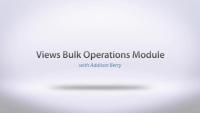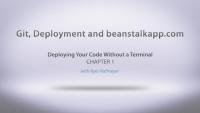In this Lullabot Module Monday lesson we are introduced to the Publish Button module. It's a simple problem, but a serious one. You've put your content editors in front of Drupal for the first time, and they can understand the node form without any problems. They understand taxonomy terms, grok menus and node references… but they get nervous when it's time to save their work. "Will... will this be published as soon as I click 'save?'" Normally, there's no good way to make the distinction between saving and publishing a piece of content explicit. Site builders can set a content type to be unpublished by default, then give editors the broad "administer nodes" permission, but that's clumsy solution that forces editors to dig for what should be a simple action: publishing or unpublishing a post. That's where the Publish Button module comes in.
Additional resources
In this Lullabot Module Monday article, we learn about the Mass Password Reset module. It's a question we all ask ourselves: What would I do if my site or server was compromised? Security professionals have loads of checklists to follow, and experienced server administrators drill for those moments. As we saw when Twitter.com was compromised by hackers, "Reset everyone's passwords, right away!" is almost always one of the important steps. If you run a Drupal site, that particular step can be frustrating. Resetting user passwords one by one is incredibly time consuming, and there's no way to do it for everyone in one fell swoop. At least, there wasn't until the release of the Mass Password Reset module.
Additional resources
An American Drupaler in London
Blog postI recently had the pleasure of traveling to London to attend DrupalCamp London. There, Joe Shindelar and I taught a one-day Introduction to Drupal workshop. The class was great and the attendees actively participated, as they were very interested in what Drupal has to offer.
In this Lullabot Module Monday lesson we take a look at the Backup and Migrate module. Few things are more terrifying than the realization that a server hiccup has wiped out a web site, or a hasty change deployed to the live site has nuked important content. Fortunately, there's a module that can help. Backup and Migrate offers site builders a host of options for manually and automatically backing up their sites' databases, and integrates with third-party backup services, to boot!
Additional resources
In this Lullabot Module Monday lesson we look at the Word Link module. It's a simple problem, but a tricky one: How can you ensure that special words and phrases, like your company's name or certain trademarks, are always linked to an appropriate web site when they're used in the text of an article? The easy answer is Word Link module: it lets you set up a custom glossary of terms that should be turned into links whenever the appear in text.
Additional resources
In this Lullabot Module Monday lesson we walk through the useful Menu Position module. It's a word that can strike fear into the heart of the bravest site builder: Breadcrumbs. Manage them well, and you'll give visitors a helpful visual indicator of where they're at in your site. Miss a detail, and the weird inconsistencies will be more confusing than no breadcrumbs at all. The challenges stem from Drupal's "flat hierarchy" -- by default, almost all pages (including every node you create) live just beneath the home page itself in an undifferentiated pool of content. All of the visual cues it sends to visitors (breadcrumb trails, highlighted parent items in the navigation menus, and so on) start with that assumption until you override them. That's where the Menu Position module helps out. It lets you set up simple rules that tell Drupal where each node type should go in the site's hierarchy, then handles all of the frustrating details automatically.
Additional resources
Lullabot Module Monday in Videos!
Blog postFor the last two years Lullabot has been writing up a post about a new contributed module every week, in a series called Module Monday. We have almost 100 modules introduced in simple, concise articles. Here at Drupalize.Me we are going to start creating video versions of these Lullabot Module Monday articles so you can have a visual walkthrough of using these modules, in addition to the written overview that the articles provide.
We're excited to share and invite you to our upcoming workshop: Git With It, an introduction to Git at MinneWebCon on April 16th. MinneWebCon is a 2-day, grassroots, knowledge-sharing conference in Minneapolis, Minnesota, that unites web lovers from every industry.
The Entity Views Attachment (EVA) module extends the Views module to allow you to attach a view to any entities on your site. Views on its own will let you create a page for your view, with its own URL, and it also lets you attach multiple views to the same Views page, but it doesn't let you do something like attach a view to a node, or a user. This lesson walks through a simple example of creating a basic view listing published articles on a site, and then using EVA to attach that view to user profiles, and making sure that we only list the published articles for that user, using a contextual filter.
Additional resources
The Views Bulk Operations (VBO) module is a great extension for the Views module, which allows you to add bulk operation checkboxes and actions to any view. You often see bulk operations on various Drupal core administration pages, like the content administration screen, which lets you select multiple pieces of content, and then perform an action, like publishing or deleting, on all items at the same time. VBO lets you add this to your administrative screens, which allows you to create very customized reports that also have time-saving actions available to them as well.
Additional resources
This week we keep rolling out handy modules that everyone should know about, with a look at two very popular modules for extending the Views module. The first, Entity Views Attachment (EVA), lets you attach any of your views to various entities on your site, like nodes or users. This is handy when you want to display a view as part of another entity on your site, instead of displaying it on its own URL.
This week's release we have three super handy modules to check out when building your site. The Module Filter module is designed to make your site administration life easier but helping you navigate the module administration page. Environment Indicator helps you sort out which site you are currently looking at and working on. This can get confusing if you are following best practices, and have several versions of the site for different stages of work (like development, staging, and live).
This week I am continuing the trend of mini-series with some lessons on deploying your code, in the FREE Deploying Your Code Without a Terminal series. The reason behind this quick set of videos is that not everyone is command line savvy, and not everyone has to be. What is important though, is getting your code into version control, and there are plenty of tools that let you do that using a graphical interface.
We introduce code deployment without a terminal using beanstalkapp.com.
Deployment means moving your code from environments such as local to production – with version control, which allows for backups, fixing mistakes, and collaborative environments.
Git is the type of version control used in Drupal, and we'll discuss Git in this lesson.
Additional resources
Deploying Your Code
FreeIn this lesson we will take the code we have committed to our remote repository and manually push it to our production server. We will cover how to setup deployments on beanstalkapp.com and the some of the advantages of using a tool like this.
A question we are commonly asked is: how did your production environment recognize the new feature?
Answer: Reverting a feature reverts it back to what is in code. So by updating the code it always looks to the code so there is no need to revert it. You usually revert a feature if you have made changes that are stored in the database and you need it to look back to the code as your database changes are not what you wanted or are wrong. If the changes you made in the database are what you want, then you update/recreate the feature.
In this lesson, we will cover the basics of getting code into version control using the Mac app "Tower" and then making the first commit and pushing it to the remote repository we will setup on beanstalkapp.com.
Want to get started with Drupal? Join us on the first day of DrupalCamp London for an Introduction to Drupal course. Led by the accomplished Drupalize.Me team, this full-day training will cover Drupal history, terminology, simple site building and how to navigate the Drupal community.
Kickstart Your Drupal Education
- Discover Drupal history and get an overview of what’s next
- Learn basic Drupal terminology
In this lesson we will cover using Lightbox2 and Colorbox with content in your site. Taking a lightbox beyond just enlarging images, we will demonstrate displaying nodes and using Views with a lightbox.
In this lesson we will use both the Lightbox2 and Colorbox modules in actual real world uses. We will demonstrate how to use each module or helper modules to use with images, create slideshows and galleries.











